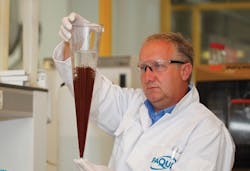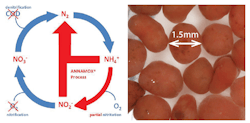Sustainable Nitrogen Removal Process Uses Less Oxygen
The Anammox conversion is an elegant shortcut in the natural nitrogen cycle. Anammox bacteria convert ammonium (NH4+) and nitrite (NO2-) into nitrogen gas. Paques developed the process for commercial purposes in cooperation with Delft University of Technology and the University of Nijmegen. Since the first full-scale plant started up in 2002 with treatment of a side stream of sludge digestion, many other Anammox plants have been installed and are running successfully.
Left: Nitrogen cycle shortcut; Right: Anammox granules
The Anammox reactor is a system in which nitritation and anammox conversion occur simultaneously in one single process unit. The natural nitrogen cycle involves various biological processes. Nitritation is the process in which ammonium is oxidized to nitrite and nitrification is the process in which ammonium is fully oxidized to nitrate. Denitrification is the process that converts nitrate with addition of an organic carbon source to nitrogen gas. Anammox (anaerobic ammonium oxidation) conversion is a shortcut in the natural nitrogen cycle in which ammonium and nitrite are converted to nitrogen gas. As the Anammox process involves removal of ammonium over nitrite (NO2-) rather than nitrate (NO3-), less oxygen (O2) is required.

